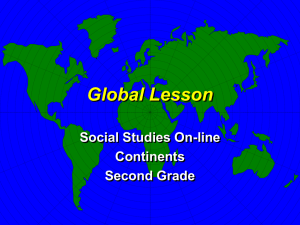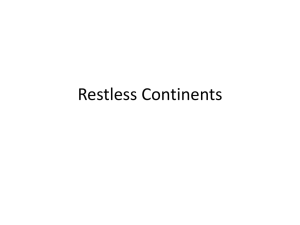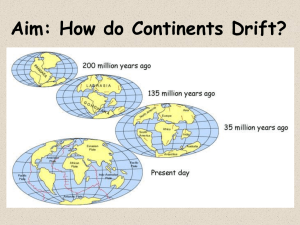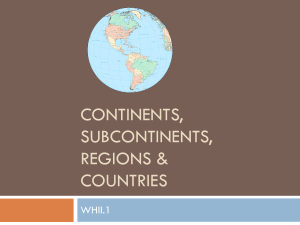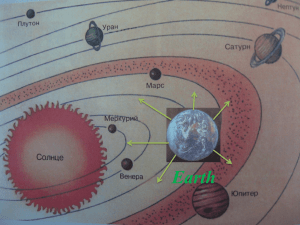Earth: Portrait of a Planet 3rd edition
advertisement
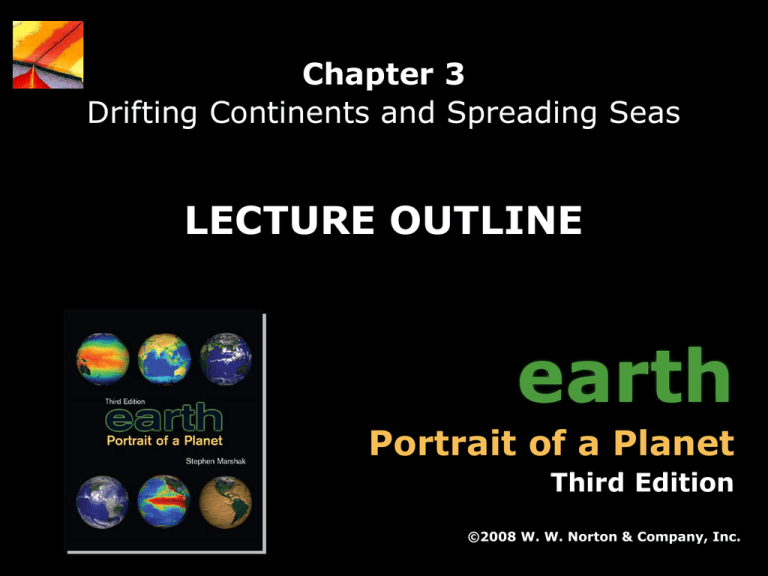
Chapter 3 Drifting Continents and Spreading Seas LECTURE OUTLINE earth Portrait of a Planet Third Edition ©2008 W. W. Norton & Company, Inc. Earth: Portrait of a Planet, 3rd edition, by Stephen Marshak Chapter 3: Drifting Continents and Spreading Seas Drifting Continents and Spreading Seas Prepared by Ronald Parker, Earlham College Department of Geosciences Richmond, Indiana Continental Drift The hypothesis that continents are mobile. Proposed by German meteorologist Alfred Wegener. The Origins of Oceans and Continents published in 1915. Wegener hypothesized a former supercontinent Pangaea. Idea was based on abundant evidence. “Fit” of the continents. Location of glaciations. Fossil evidence. Rock type and structural similarities. Paleoclimatic evidence. Earth: Portrait of a Planet, 3rd edition, by Stephen Marshak Chapter 3: Drifting Continents and Spreading Seas Continental Drift Wegener’s idea was debated and ridiculed. Most scientists didn’t believe him. Lack of a mechanism for drift a major criticism. Wegener died in 1930 at the age of 40. Lacking an advocate, the drift hypothesis faded. His idea was revived in the 1950s. Earth: Portrait of a Planet, 3rd edition, by Stephen Marshak Chapter 3: Drifting Continents and Spreading Seas Continental Drift Now we can measure drift; Wegener was right! Sea-floor spreading. Subduction. Plate tectonics. Why was Wegener’s model dismissed by scientists? Earth: Portrait of a Planet, 3rd edition, by Stephen Marshak Chapter 3: Drifting Continents and Spreading Seas Before Continental Drift What were scientists thinking? The oceans and the continents were permanently fixed. There were no changes in continents back in time. Evidence of drastic changes interpreted as… Shrinkage effects. Rebound from thick sediment loading. The result of “upheaval.” Earth: Portrait of a Planet, 3rd edition, by Stephen Marshak Chapter 3: Drifting Continents and Spreading Seas Continental “Fit” Wegener noted the continents seem to fit together. He argued that the fit could not be coincidental. Present shorelines make a rough fit. The continental shelf edges make a better fit. Earth: Portrait of a Planet, 3rd edition, by Stephen Marshak Chapter 3: Drifting Continents and Spreading Seas Glacial Evidence Permian glacial till is found on 4 continents. The tills in Africa and India are now near equator. A cooler earth? No, tropical plants also preserved. Earth: Portrait of a Planet, 3rd edition, by Stephen Marshak Chapter 3: Drifting Continents and Spreading Seas Paleoclimatic Evidence Placing Pangea over the Permian South Pole… He correctly predicted… Tropical coals. Tropical reefs. Subtropical deserts. Subtropical evaporites. Earth: Portrait of a Planet, 3rd edition, by Stephen Marshak Chapter 3: Drifting Continents and Spreading Seas Fossil Evidence Identical fossils found on widely separated land. Mesosaurus – A freshwater reptile. Glossopteris – Subpolar plant with heavy seeds. Earth: Portrait of a Planet, 3rd edition, by Stephen Marshak Chapter 3: Drifting Continents and Spreading Seas Fossil Evidence Identical fossils found on widely separated land. Lystrosaurus – A non-swimming, land-dwelling reptile. Cynognathus – A non-swimming, land-dwelling reptile. These organisms could not have crossed an ocean. Earth: Portrait of a Planet, 3rd edition, by Stephen Marshak Chapter 3: Drifting Continents and Spreading Seas Matching Geology Geologic phenomena match across the Atlantic. Geologic structures. Rock types. Rock ages. Earth: Portrait of a Planet, 3rd edition, by Stephen Marshak Chapter 3: Drifting Continents and Spreading Seas Matching Geology Geologic phenomenon match across the Atlantic. Mountain belts. Appalachians. Caledonides. Earth: Portrait of a Planet, 3rd edition, by Stephen Marshak Chapter 3: Drifting Continents and Spreading Seas Criticisms of Drift Why wasn’t continental drift accepted? There were no mechanisms for moving continents. Wegener suggested that continents plowed through the ocean crust, much like ice breakers cut through ice. He invoked rotational (centrifugal) forces. These ideas were easily discredited; so was his theory. Earth: Portrait of a Planet, 3rd edition, by Stephen Marshak Chapter 3: Drifting Continents and Spreading Seas Continental Drift When Wegener died, the debate did too. A few continued to champion Wegener’s idea. Arthur Holmes –Earth’s mantle moved by convection. The drift hypothesis awaited the evidence provided by paleomagnetism (see Interlude A). Earth: Portrait of a Planet, 3rd edition, by Stephen Marshak Chapter 3: Drifting Continents and Spreading Seas The Ocean Floor In the 1950s, ocean bathymetry was mapped by sonar. Oceanographers were surprised to discover that… The deepest parts of the ocean occur near land. A mountain range runs through every ocean basin. Submarine volcanoes form lines across ocean floors. Earth: Portrait of a Planet, 3rd edition, by Stephen Marshak Chapter 3: Drifting Continents and Spreading Seas The Ocean Floor Sonar mapping delineated bathymetric features. Trenches. Mid-ocean ridges (MORs). Seamounts, Guyots. Earth: Portrait of a Planet, 3rd edition, by Stephen Marshak Chapter 3: Drifting Continents and Spreading Seas The Ocean Floor Modern views of the ocean floor reveal: Mid-ocean ridges. Trenches. Fracture zones. Earth: Portrait of a Planet, 3rd edition, by Stephen Marshak Chapter 3: Drifting Continents and Spreading Seas Oceanic Crust By 1950, we had learned much about oceanic crust. Oceanic crust is covered by sediment. Thickest near the continents. Thinnest (or absent) at the mid-ocean ridge. Oceanic crust is mafic (basalt and gabbro). No granitic rocks. No metamorphic rocks. High heat flow characterizes the mid-ocean ridge. Earth: Portrait of a Planet, 3rd edition, by Stephen Marshak Chapter 3: Drifting Continents and Spreading Seas Oceanic Crust Belts of concentrated subsea earthquakes were found. The earthquakes were surprising. They were limited to… Parts of oceanic fracture zones. Mid-ocean ridge axes. Deep ocean trenches. Earth: Portrait of a Planet, 3rd edition, by Stephen Marshak Chapter 3: Drifting Continents and Spreading Seas Sea Floor Spreading In 1960, Harry Hess published his “Essay in Geopoetry.” He called his theory “sea-floor spreading.” Upwelling mantle erupts at the mid-ocean ridges. New crust moves away from ridges, gathering sediment. At trenches the sea-floor dives back into the mantle. Provided a potential mechanism for continental drift. Earth: Portrait of a Planet, 3rd edition, by Stephen Marshak Chapter 3: Drifting Continents and Spreading Seas Magnetic Anomalies Towed magnetometers measure ocean crust. Magnetism oscillates perpendicular to the MOR. These variations are + and - magnetic anomalies. Anomalies are linear belts that parallel MOR. Earth: Portrait of a Planet, 3rd edition, by Stephen Marshak Chapter 3: Drifting Continents and Spreading Seas Magnetic Reversals Layered lava flows reveal reversals in polarity. Magnetic polarity is the direction of magnetic north. When reversed, the north magnetic pole is near the south geographic pole. Reversals are geologically rapid. Earth: Portrait of a Planet, 3rd edition, by Stephen Marshak Chapter 3: Drifting Continents and Spreading Seas Magnetic Reversals Radioactivity permits rock age-dating. A geomagnetic reversal time scale has been assembled. Reversals occur every 500-700 ka. 171 are known since the end Cretaceous. Earth: Portrait of a Planet, 3rd edition, by Stephen Marshak Chapter 3: Drifting Continents and Spreading Seas Sea-Floor Spreading: Proof Polarity reversals explain magnetic anomalies. Positive anomalies – Crust with normal polarity. Negative anomalies – Crust with reversed polarity. Magnetic anomalies are symmetric across the MOR. Earth: Portrait of a Planet, 3rd edition, by Stephen Marshak Chapter 3: Drifting Continents and Spreading Seas Sea-Floor Spreading: Proof Magnetic anomalies mimic layered lava flows. Magnetic “stripes” form as lava cools at a MOR. Ocean crust spreads away from MOR. Reversals are recorded within cooled lava. SF spreading is the mechanism of continental drift. Earth: Portrait of a Planet, 3rd edition, by Stephen Marshak Chapter 3: Drifting Continents and Spreading Seas Sea-Floor Spreading Ages increase away from the MOR. Ages are “mirror images” across the MOR. Earth: Portrait of a Planet, 3rd edition, by Stephen Marshak Chapter 3: Drifting Continents and Spreading Seas This concludes the Chapter 3 Drifting Continents and Spreading Seas LECTURE OUTLINE earth Portrait of a Planet Third Edition ©2008 W. W. Norton & Company, Inc. Earth: Portrait of a Planet, 3rd edition, by Stephen Marshak Chapter 3: Drifting Continents and Spreading Seas

